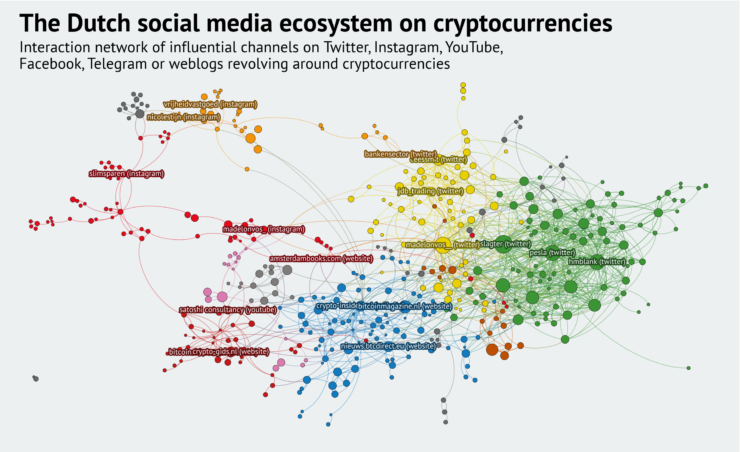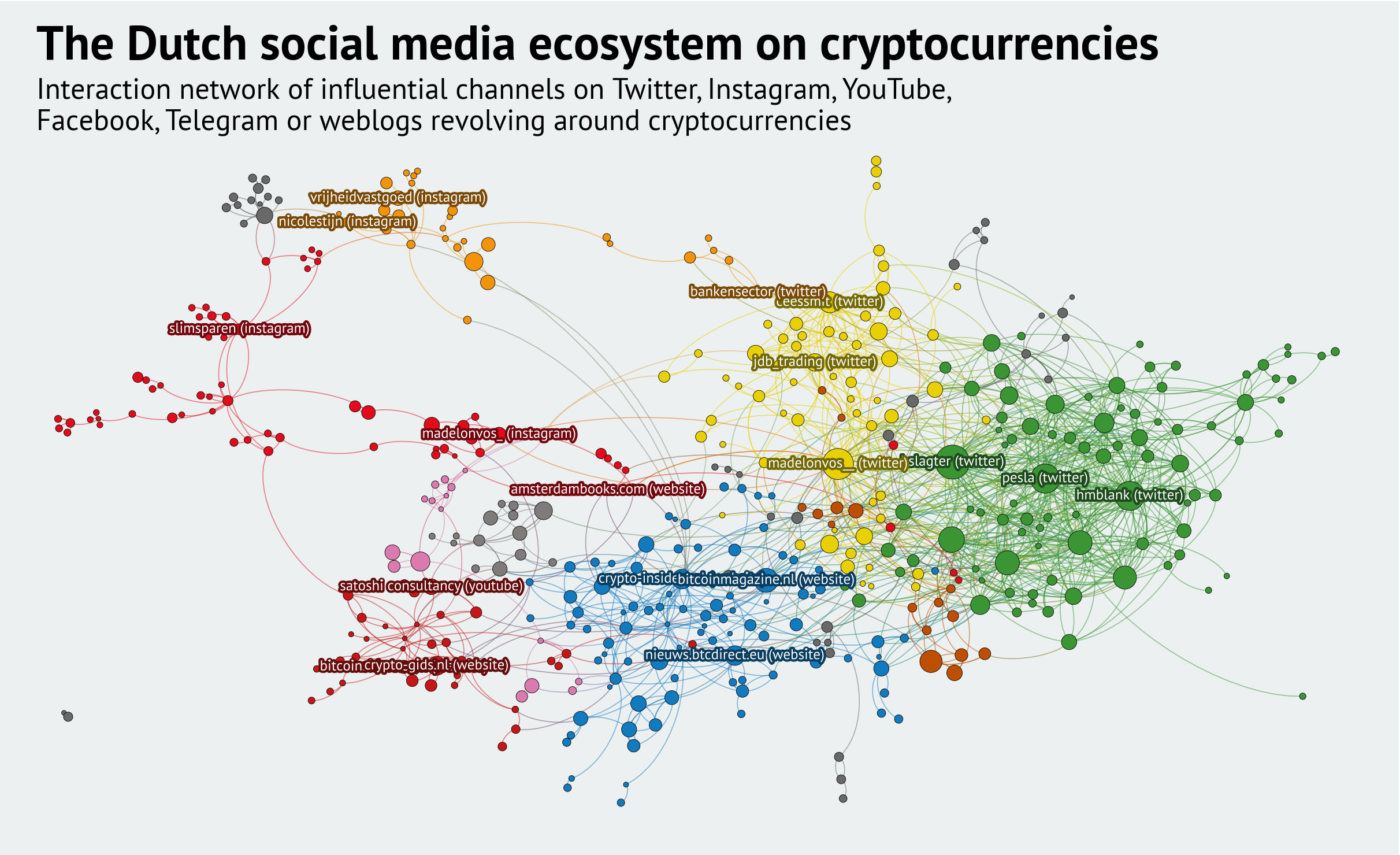Inside the Dutch online crypto ecosystem
Team: Joris Veerbeek & Sofie de Wilde de Ligny
The online discussion around cryptocurrencies is––to say the least-–lively. There are finfluencers, get-rich-quick vloggers, financial “coaches”, former wallstreet brokers discussing the next big coin–even right-wing radical politicians promising to come up with their own currency. Talks about “pumps” and “dumps” but also posts expressing a deep mistrust in the central banking system, presenting bitcoin as the reasonable alternative. For our case study, we’ve studied the discourse and the communities around cryptocurrencies on social media in the Netherlands.
Whereas most network analyses on social media data focus on a single platform, we instead aimed to develop a methodology for mapping out the broader social media “ecosystem” of outlets related to a single societal debate in the Netherlands. Thus, we do not only consider a platform’s internal interactions (retweets, comments, likes), but also allow for interactions between users or channels on different platforms. When a Twitter user posts a tweet containing a link to a YouTube video, for example, we consider this to be an interaction between the Twitter user and the YouTube channel.
To create our platform independent network, we used the following approach:
- We first manually compiled a seed list of 200 Dutch channels on Twitter, YouTube, Instagram, Telegram and Facebook related to the topic of cryptocurrencies. For every account or channel in the seed list, we collect both all platform-internal hyperlinks (mentions on Facebook, retweets on Twitter, tags on Instagram, reposts on Telegram) and platform-external hyperlinks (URL’s from outside the platform). We do this by combining a variety of API’s and scrapers. For Twitter, we collect references using the Academic API. For YouTube and Telegram, we use their standard API’s. For Instagram, we use the Python package `Instaloader`. For Facebook, we manually save the page referenced and parse the page using the Python package `lxml`. For references to other types of websites (e.g. references to news sites), we first check whether an RSS feed exists on the website, and otherwise try to parse it using the Python package `newspaper`.
- After collecting all hyperlinks, we parse the platform-external hyperlinks using a custom parser that automatically extracts both the referenced platform and channel. In the case of ‘http://t.me/cryptostackerz’, for example, the referenced platform is Telegram, and the referenced channel ‘cryptostackerz’. In some cases, this is less trivial than it might seem at first glance. YouTube references, for example, come in various forms and the user name often can’t be extracted from the URL alone. Therefore, we write several platform specific rules to extract the user names for the URL’s.
- After parsing a hyperlink, our goal was to collect other relevant channels within the crypto communities that aren’t included in the seed list. We store all references in a dictionary with the channel-medium tuple as the key and the number of times this tuple is referenced as the value. To find other relevant channels, we randomly pick one channel out of the dictionary using the relative number of times this channel is referenced as the probability. Put differently: the more a channel-platform tuple is referenced by other channels, the higher the chance of the channel being picked.
- If a certain tuple is picked, we collect a small sample of at most twenty messages – or, in the case of YouTube: videos – from the tuple, and check for two things. First, we check whether the channel is Dutch using the Python package `WhatTheLang`. We consider a channel to be Dutch if at least 20% of the messages in the sample is classified as such. Second, we check whether a channel is actually related to crypto communities. We do this to filter out references to generic news sites such as nu.nl. We use the same list of keywords related to crypto communities that was mentioned earlier and look for occurrences of those keywords in the sample. If we can find at least one post related to cryptocurrencies in the sample, we include it in our analysis. If a channel is included in our analysis, we extract all references, update our dictionary and pick a new channel to retrieve. We let this process run over the course of approximately three weeks, which resulted in a total collection of 38.059 references between 510 channels related to cryptocurrencies online.

Our most relevant results were:
- Using a network analysis, we found that Twitter users interacted with each other most frequently but are not necessarily centrally positioned within the network. Rather, most twitter users can be found in the green-coloured community on the right side. News-like websites , on the other hand, were found to be more central in the network, and were referenced by channels from a variety of platforms.
- Twitter is the most political platform compared to the other platforms. Increasing public criticism of cryptocurrency appears to be an important element in various discourses on Twitter, based on current events, such as the war with Russia and inflation.
- Instagram focuses on lifestyle instead of politics. We see accounts like “slimsparen” and “vrijheidvastgoed” (freedom through property). The results have shown that a particular lifestyle is prominent on Instagram, this lifestyle promotes a passive and independent income powered by cryptocurrency. For example, multiple accounts criticize paid employment and emphasizing the importance of a passive and independent income.
- YouTube channels – most of them located on the left bottom of the network – focus primarily on the practice of earning a passive income. Moreover, the results show that several keywords point to claims that videos should not be construed as financial advice, in which YouTube is unique.
- Telegram is the most challenging platform to interpret, and are relatively spread throughout the network. However, Telegram indicates similarities to Twitter and YouTube. Telegram is similar to Twitter in cryptocurrency-related discourses and similar to the informative character of YouTube. The main difference between Telegram and the other platforms is that Telegram also focuses on foreign commerce. Also, multiple (key)words indicate deviating coins that do not or hardly occur on the other platforms.

